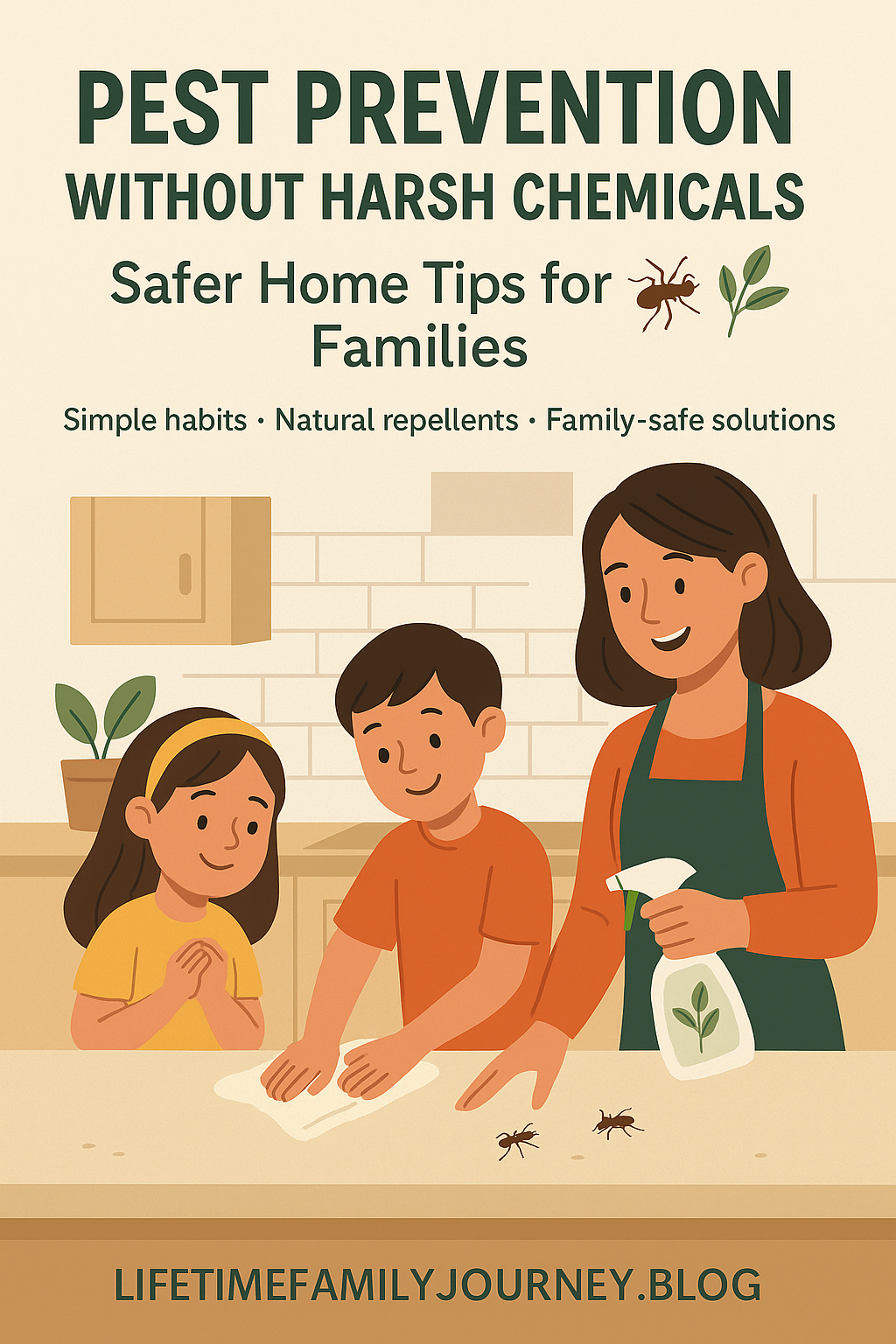Pest Prevention Without Harsh Chemicals: Safer Home Tips 🐜🌿
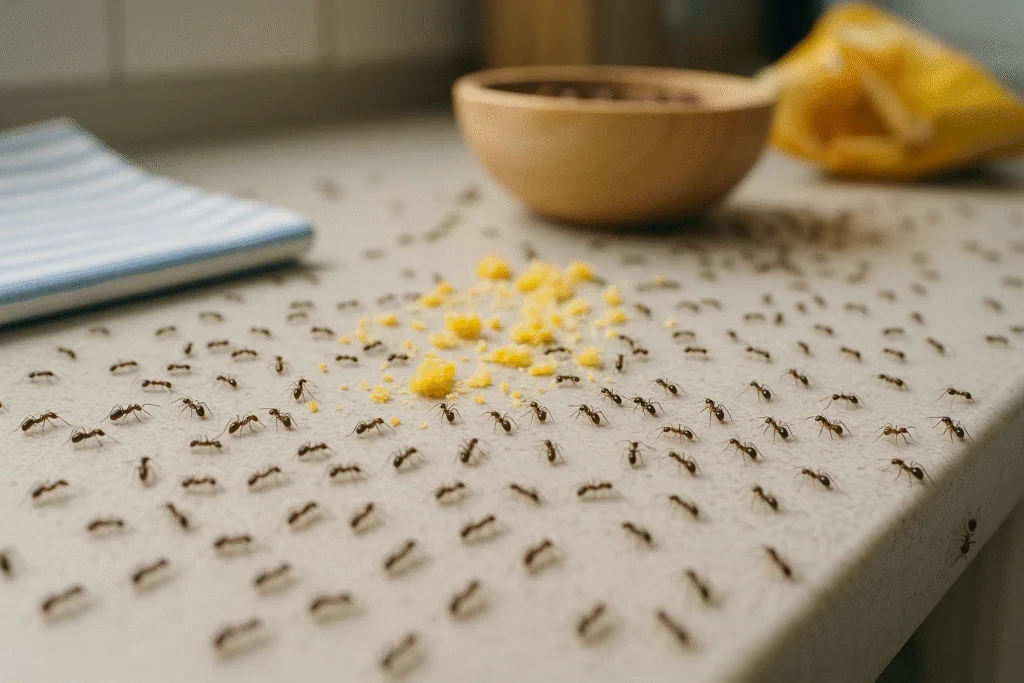
The lights flicked on in my kitchen at 2 AM, and I watched an entire army of ants scatter across my counter like someone had just yelled “RAID!” at their little ant convention 🐜. There they were, marching in perfect formation toward the sticky remnants of what I’m pretty sure used to be a popsicle—courtesy of my 6-year-old son, Brayden, who apparently thinks kitchen counters are just horizontal napkins.
Ants don’t pay rent, but they sure act like they own the place. 😤
After twelve years in the Air Force working on aircraft hydraulics, I thought I knew something about precision and problem-solving. But nothing prepared me for the tactical warfare that is keeping pests out of a house with six kids. Between Melody’s midnight snack raids, Gabrielle’s art projects that somehow involve glitter AND crumbs, and the fact that my teenagers treat our pantry like a 24-hour convenience store, our home basically sends out engraved invitations to every bug within a five-mile radius.
Here’s what I’ve learned after two decades of marriage and countless pest encounters: you don’t need a chemistry degree or a hazmat suit to keep unwanted critters at bay. Pest prevention without harsh chemicals isn’t just possible—it’s actually more effective in the long run, safer for your family, and won’t leave your house smelling like a science experiment gone wrong. 🧪❌
Quick Reality Check: What Are We Really Dealing With? 🤔
Let me ask you this—have you ever walked into your kitchen and felt like you’re entering a crime scene? Crumbs everywhere, mysterious sticky spots, and evidence of midnight snack raids that would make a detective weep? Yeah, that’s basically a VIP invitation to every pest in your zip code. 📍
Why Skip Harsh Chemicals? The Real Talk Every Parent Needs 🚫💀
Let me paint you a picture. You spray that “industrial strength” ant killer, and sure enough, the ants disappear. Victory! 🎉 Except now your toddler is crawling across the same floor where you just unleashed enough chemicals to power a small rocket ship.
That lemon-fresh scent? Sometimes it’s just lemon-flavored headache material. 🍋😵
The Hidden Costs of Chemical Pest Control:
• Respiratory Issues → Kids already breathe like they’re training for marathons just walking upstairs 🏃♂️💨
• Surface Residue → Chemicals stick around on places where your family plays and eats 🍽️
• Groundwater Contamination → Today’s kitchen spray = tomorrow’s drinking water problem 💧⚠️
• Pet Safety Concerns → Fido doesn’t understand “freshly sprayed—keep out” 🐕❌
But here’s the kicker: many of these products can contaminate groundwater, which means what you’re spraying in your kitchen today could end up in someone’s drinking water tomorrow. As a dad, that sits about as well with me as finding out my teenager has been using my credit card for DoorDash without permission. 💳😱
The good news? Natural pest control methods aren’t just safer—they’re often more sustainable and cost-effective. Plus, you won’t need to evacuate the house every time you want to deal with a few unwanted visitors. 🏠✅
💰 Cost Comparison: Natural vs. Chemical Solutions
| Method Type | Initial Cost | Monthly Cost | Safety Rating | Effectiveness |
|---|---|---|---|---|
| Chemical Sprays | $15-30 | $10-20 | ⚠️ Caution | 🔥 Fast/Temporary |
| Natural Methods | $5-15 | $2-5 | ✅ Family Safe | 🌱 Slow/Lasting |
| Professional Chemical | $150-300 | $50-100 | ⚠️ Caution | 🔥 Fast/Temporary |
| Eco-Professional | $200-400 | $30-60 | ✅ Safe | 🌟 Comprehensive |
Seal & Block: Your Home’s First Line of Defense 🏰🔒
Think of your house like a fortress, except instead of keeping out enemy armies, you’re keeping out tiny invaders who are really, really good at finding the smallest possible entry points. I learned this lesson the hard way when I followed an ant trail from my kitchen counter all the way to a crack under our back door that was so small I needed a magnifying glass to see it properly. 🔍
The prevention game starts with sealing every possible entry point. We’re talking caulking around windows and doors, adding weather stripping where it’s worn out, repairing or replacing damaged screens, and making sure your chimney has a proper cap.
🛠️ Your Home Sealing Checklist:
→ Windows & Doors:
• Caulk gaps around frames
• Replace worn weather stripping
• Check screen integrity
• Inspect door sweeps
→ Foundation & Basement:
• Seal cracks in foundation walls
• Check utility entry points
• Install proper drainage systems
• Use steel wool for pipe gaps
→ Roof & Attic:
• Install chimney caps
• Check vent screens
• Seal soffit gaps
• Inspect roof-wall connections
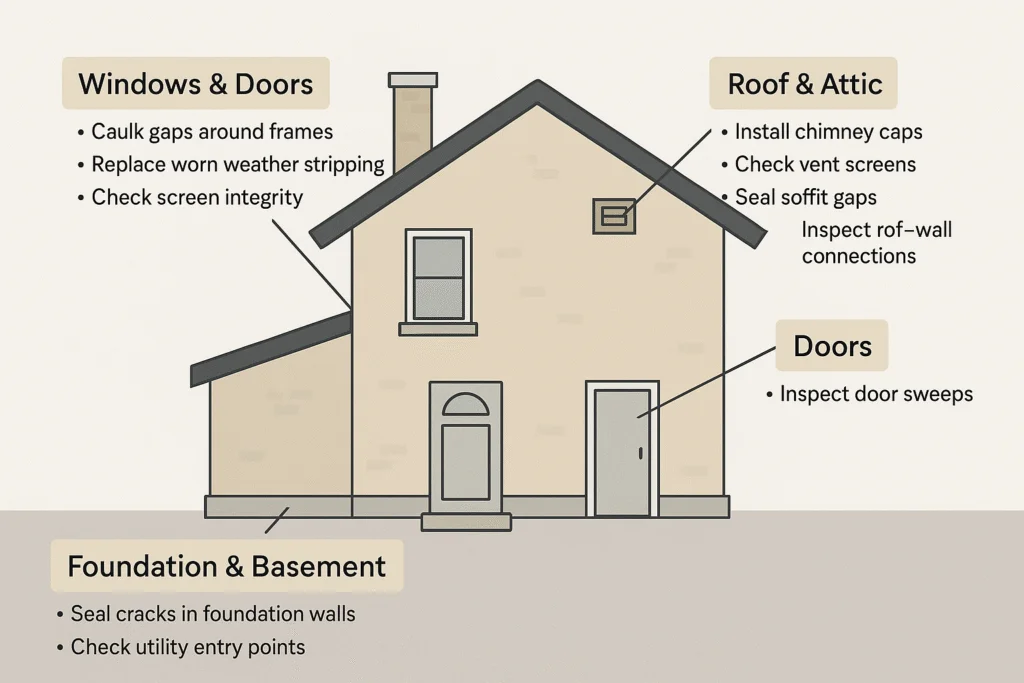
I know it sounds tedious, but trust me—spending a Saturday afternoon with a caulk gun beats spending every Saturday afternoon in chemical warfare with creatures that reproduce faster than my kids can dirty their laundry. 🧺😅
Don’t forget about your basement and foundation areas. Poor drainage can create the kind of moisture problems that turn your home into a five-star resort for pests. If you’re dealing with water issues down there, you might want to check out our guide on French drain installation and basement waterproofing to tackle the root cause. 💧🏠
Pro Dad Tip: Steel wool is your secret weapon for filling gaps around pipes and utilities. Mice can squeeze through holes the size of a dime, but they can’t chew through steel wool. It’s like kryptonite for rodents. 🦸♂️✨
🐭 Rodent Entry Point Size Guide:
• Mouse = As small as 6 mm (pencil width)
• Young Rat = Quarter-sized hole (24mm)
• Adult Rat = Half-dollar sized hole (30mm)
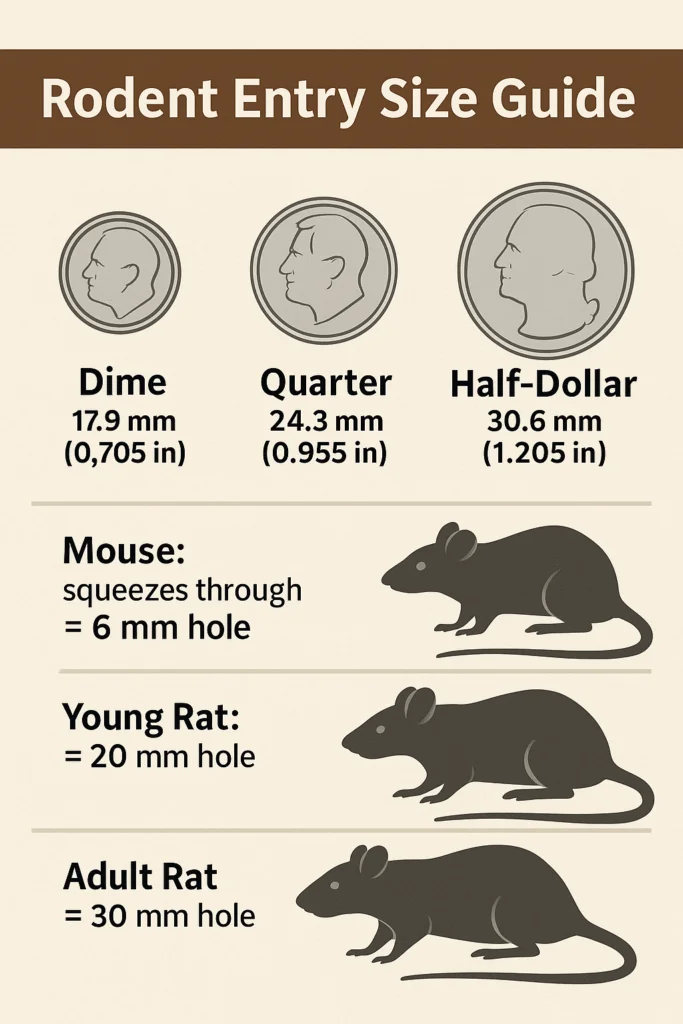
If you can fit a pencil through it, assume a mouse can squeeze through too! ✏️➡️🐭
Clean Habits That Starve Pests Into Submission 🧹💪
I’ll be honest—maintaining a spotless house with six kids is like trying to fold fitted sheets in a hurricane. 🌪️ But when it comes to pest prevention without harsh chemicals, cleanliness is your most powerful weapon.
My son Brayden leaves crumbs like he’s marking a treasure map straight to our pantry. 🗺️🍪
Question for you: Have you ever noticed how ants seem to appear out of nowhere the moment someone spills juice? It’s like they have a secret communication network faster than our family group text! 📱
🏆 The Daily Victory Routine:
Every Night (5 minutes max):
• Wipe down all food prep surfaces 🧽
• Quick sweep of dining areas 🧹
• Secure all trash with tight lids 🗑️
• Store opened snacks in sealed containers 📦
Weekly Deep Dive (30 minutes):
• Behind/under appliances cleaning
• Pantry organization check
• Pet food area maintenance
• Basement/storage area sweep
The key is developing habits that become second nature. Every night, after the dinner chaos settles and I’ve successfully located all the missing forks (usually under someone’s placemat), I do a quick counter wipe-down. Not because I’m obsessively clean—trust me, ask my wife—but because I’ve learned that food residue is like a neon sign advertising “Free Buffet” to every ant in the neighborhood. 🍽️🐜
Your trash cans need tight-fitting lids, and here’s something I learned the hard way: even the smallest amount of standing water can become a breeding ground for mosquitoes. We’re talking about the water that collects in plant saucers, pet bowls left outside, or that decorative fountain your wife insisted would “add ambiance” to the backyard. ⛲😅
💧 Hidden Water Sources (Mosquito Breeding Central):
• Plant saucers → Empty weekly
• Clogged gutters → Clean seasonally
• Pet water bowls → Change daily
• Kiddie pools → Cover when not in use
• Birdbaths → Fresh water every 3 days
Monthly pantry and fridge sweeps are non-negotiable. I rotate through our food storage areas like I’m conducting inventory at a military commissary, checking expiration dates and looking for any signs of pest activity. Sounds intense? Maybe. But finding a family of pantry moths before they turn your flour into their personal nursery is worth the effort. 🦋❌
The beauty of this approach is that these cleaning habits don’t just prevent pests—they keep your home organized and functional. It’s like killing two birds with one stone, except we’re not killing anything, just preventing uninvited guests. Speaking of organization, if you’re looking for ways to keep kids’ spaces tidy and functional, check out our DIY kids room ideas that actually work in real family life. 🛏️✨
Natural Repellents That Actually Work (No Snake Oil Here) 🌿⚡
Let’s talk about natural pest control methods that have been tested in the trenches of real family life. I’m not talking about old wives’ tales or Pinterest projects that look pretty but don’t actually solve problems—I mean solutions that work when you’ve got kids tracking in mud and teenagers who think “clean up after yourself” is a foreign language. 🥾👫
Ever wonder why some natural solutions work while others are complete duds? It’s all about understanding what pests actually hate versus what sounds good in theory. 🤔
🕷️ Spider Kryptonite: Peppermint Power
Peppermint oil is like kryptonite for spiders. Mix about 10-15 drops with water in a spray bottle, and spray it around doorways, windows, and anywhere you’ve seen our eight-legged friends setting up shop. The smell is actually pleasant (unlike most commercial repellents), and it’s completely safe around kids and pets.
📊 Peppermint Oil Effectiveness Chart:
Spiders: ████████████ 90% effective
Ants: ███████░░░░░ 65% effective
Mice: ██████░░░░░░ 55% effective
Roaches: ████░░░░░░░░ 35% effective
Fair warning: your house shouldn’t smell like you’ve been huffing candy canes! 🍭
🐜 Ant Highway Disruption: The Vinegar Solution
For ants, white vinegar is your best friend. These little marchers follow scent trails like they’re following GPS directions, and vinegar disrupts those chemical highways. I spray a 50-50 vinegar and water solution along their trails and entry points.
→ Pro Application Tips:
• Spray directly on ant trails ✨
• Focus on entry points (cracks, gaps)
• Reapply after cleaning or rain
• Expect pickle factory smell for 2-3 hours 🥒
🥄 Diatomaceous Earth: The Microscopic Warrior
Food-grade diatomaceous earth is another game-changer for safe pest solutions. It’s basically microscopic fossilized algae that feels like powder to us but is like walking across broken glass for insects.
Application Strategy:
• Sprinkle thin lines around problem areas 📏
• Focus on cracks and crevices
• Reapply after vacuuming or moisture
• Use food-grade only (NOT pool filter grade!) ⚠️
🪤 Strategic Trap Placement Guide:
Sticky traps and light traps work great for flying insects without introducing any chemicals into your home environment. Place them strategically, and they’ll catch problems before they become infestations.
Kitchen: Near windows + under sinks
Bathrooms: Behind toilets + near drains
Basement: Corners + near utilities
Garage: Entry points + storage areas
If you’re already making the switch to safer household products, you might want to read about safe cleaning products that complement your chemical-free pest prevention strategy. 🧽✅
Yard & Outdoor Protection: Creating a Pest-Free Perimeter 🌳🛡️
Your yard is like the front lines in the war against household pests. What happens outside your house directly affects what tries to get inside, so creating a chemical-free home environment starts beyond your front door. 🚪
Think about it—when was the last time you really looked at your yard as a pest highway system? Those overgrown bushes touching your siding? That’s basically a superhighway with a “Welcome Home” sign for every creepy crawly in the neighborhood! 🛣️🐛
🌿 Landscape Modification Checklist:
→ Vegetation Management:
• Trim shrubs 2+ feet from house walls
• Cut tree branches away from roof
• Remove ivy/vines on exterior walls
• Keep grass short near foundation
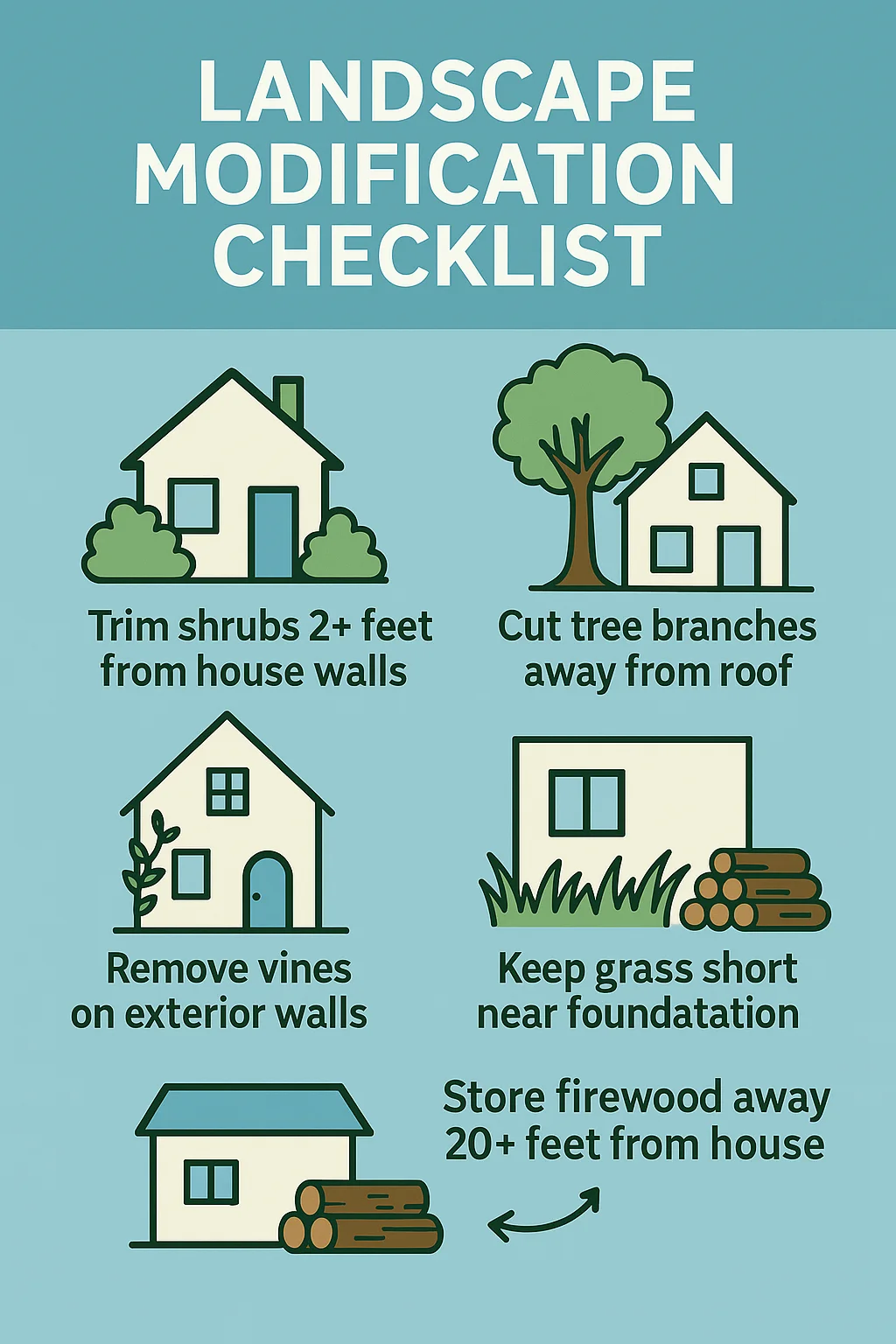
→ Water Source Elimination:
• Fix leaky outdoor faucets 🔧
• Clear clogged gutters regularly
• Empty decorative water features weekly
• Ensure proper yard drainage
I learned this lesson when I discovered a superhighway of ants using our overgrown azalea bush like their personal escalator to our kitchen window. 🏠🐜
🦟 Mosquito Breeding Prevention Guide:
Standing water is the enemy. Check your gutters, empty flower pot saucers regularly, and make sure your yard drains properly after rain. Mosquitoes can breed in as little as a bottle cap’s worth of water, and trust me, having a mosquito nursery in your backyard is like hosting a tiny vampire convention. 🧛♂️
Water Volume → Mosquito Capacity:
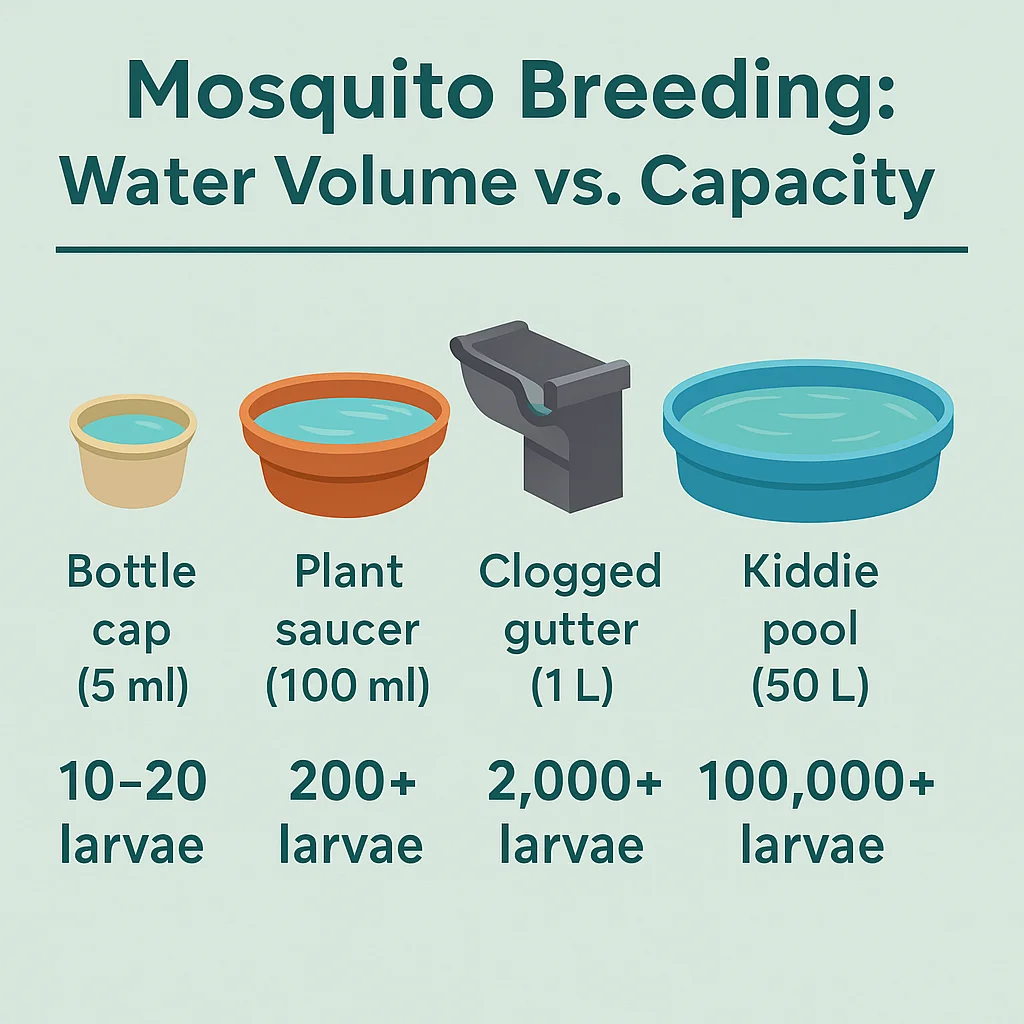
For natural mosquito control, Bacillus thuringiensis israelensis (BTI) dunks are incredibly effective and completely safe for kids, pets, and wildlife. Drop them in areas where water naturally collects but can’t be eliminated, like storm drains or decorative water features. 🎯
🪵 Firewood Storage Strategy:
Store firewood at least 20 feet away from your house and keep it off the ground. Woodpiles against your foundation are like luxury condos for termites, carpenter ants, and various rodents who appreciate both the shelter and the proximity to your home’s dining facilities. 🏨🐜
Optimal Firewood Setup:
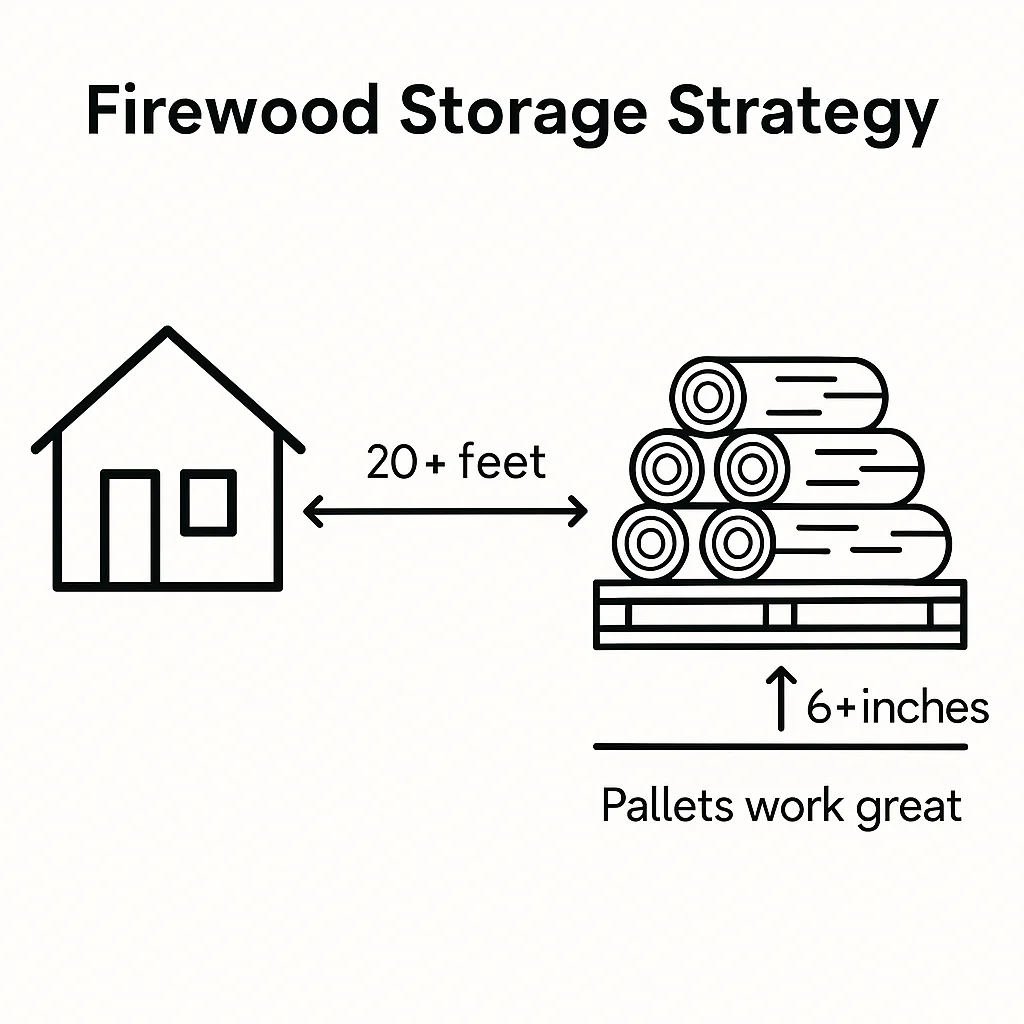
The CDC’s mosquito prevention guidelines provide excellent additional strategies for keeping these disease-carrying pests at bay without resorting to harsh chemical treatments. 📋✅
Family & Pet-Safe Rodent Prevention 🐭🛡️
Mice don’t just nibble cheese—they’ll chew through your granola bars like it’s a midnight buffet. 🧀🍫
Rodent prevention in a family home requires a different approach than what you might use in a commercial setting. We’re talking about family-friendly pest prevention that doesn’t put anyone at risk—including curious pets and children who have a talent for getting into everything. 👶🐕
Let me ask you something—have you ever found mysterious bite marks on food packaging and wondered if you’re living in a real-life cartoon? That’s your wake-up call that Mickey and friends have moved in without paying rent! 🏠💸
🏠 Rodent Entry Point Priority Areas:
→ Garage & Attic Access:
• Seal gaps around pipes and vents
• Check where utilities enter the building
• Inspect door seals and thresholds
• Look for gaps where materials meet
→ Foundation Vulnerabilities:
• Cracks in concrete/brick
• Gaps around basement windows
• Utility line entry points
• Crawl space access areas
Here’s something I wish I’d known earlier: mice can squeeze through holes the size of a dime, and rats can fit through holes the size of a quarter. When you’re checking for entry points, use these measurements as your guide.
🪙 Size Reference Guide:
• Dime (17.9mm) = Mouse highway 🐭
• Quarter (24.3mm) = Young rat access 🐀
• Half-dollar (30.6mm) = Adult rat entrance 🐀💪
If you can fit a pencil through a gap, assume a mouse can squeeze through too! ✏️➡️🐭
🪤 Safe Trapping Strategy (No Poison!):
Instead of poison baits that could harm pets or children, invest in high-quality snap traps or humane live traps. Place them along walls where you’ve seen droppings or gnaw marks, using peanut butter or dried fruit as bait.
Effective Bait Options (Ranked by Success):
- Peanut Butter 🥜 → 95% success rate
- Dried Fruit/Nuts 🍇 → 85% success rate
- Chocolate 🍫 → 75% success rate
- Cheese 🧀 → 45% success rate (overrated!)
⚡ Quick Trap Placement Tips:
• Against walls (mice travel along edges)
• Near evidence (droppings, gnaw marks)
• In quiet, undisturbed areas
• Check and rebait every 2-3 days
The key is persistence—check and rebait traps regularly, and don’t get discouraged if it takes time to solve the problem. 💪
🏠 Prevention > Treatment Always:
Keep pet food in sealed containers, maintain clean floors and counters, and eliminate clutter where rodents could nest. Your basement and storage areas should be organized and clean—mice love nothing more than a cozy pile of old newspapers or cardboard boxes to call home. 📦🏠
When DIY Isn’t Enough: Safer Professional Options 🔧👨🔧
Sometimes, despite your best efforts with pest prevention without harsh chemicals, you need to call in reinforcements. Maybe you’re dealing with a termite situation, a serious wasp nest, or a rodent problem that’s beyond what weekend warrior tactics can handle. 🐝⚔️
Question: How do you know when it’s time to wave the white flag and call the pros? Here are the red flags that mean it’s time to get help:
🚨 Call-the-Pros Alert Signs:
• Structural damage (termites, carpenter ants) 🏠💥
• Large nests in dangerous locations (wasps, hornets)
• Health risks (rats in kitchen, bats in living areas)
• Recurring infestations despite your best efforts
• You’re spending more time fighting pests than with family! 👨👩👧👦
The good news is that the pest control industry has evolved significantly. Many companies now offer eco-friendly options that use integrated pest management (IPM) principles. These approaches focus on understanding pest behavior, eliminating root causes, and using the least toxic methods necessary to solve the problem. 🌱🎯
🌿 Modern Eco-Friendly Professional Methods:
→ Heat Treatments:
• Effective for bed bugs and certain pests
• No chemicals whatsoever
• Family can often stay in home during treatment
→ Targeted Applications:
• Precise placement minimizes exposure
• Uses smaller amounts of safer products
• Focuses on pest pathways, not living areas
→ IPM (Integrated Pest Management):
• Combines multiple strategies
• Emphasizes prevention over treatment
• Long-term solutions vs. quick fixes
When interviewing pest control companies, ask about their safe pest solutions and request information about any products they plan to use. A reputable company will be transparent about their methods and happy to explain how their approach protects your family’s health. 💬✅
📋 Questions to Ask Potential Pest Control Companies:
• “What specific products will you use in my home?”
• “How long before my family can safely return to treated areas?”
• “Do you offer eco-friendly or low-toxicity alternatives?”
• “What’s your approach to preventing future infestations?”
• “Can you provide safety data sheets for all products?”
The EPA’s Integrated Pest Management resources provide excellent guidance on what to look for in a professional service that aligns with your commitment to maintaining a healthy home environment. 📚🏠
Don’t be afraid to get multiple quotes and ask tough questions. This is your family’s health we’re talking about, and any professional worth hiring will understand and respect your concerns about chemical exposure. 💪👨👩👧👦
Build a Routine: Small Habits, Big Impact 📅💪
Creating a sustainable pest prevention without harsh chemicals system isn’t about perfection—it’s about building habits that become as automatic as brushing your teeth. With six kids, I’ve learned that the only systems that work long-term are the ones that don’t require superhuman effort to maintain. 🦷✨
Here’s a reality check—are you trying to do everything at once and burning out after two weeks? Trust me, I’ve been there. The key is starting small and building momentum. 🏃♂️💨
📊 The Family Pest Prevention Schedule:
🗓️ WEEKLY TASKS (15-20 minutes total):
• Monday: Quick pantry check while making grocery list 📝
• Wednesday: Wipe down all food surfaces during dinner cleanup 🧽
• Friday: Empty all trash before weekend chaos begins 🗑️
• Saturday: Sweep/vacuum main living areas during coffee time ☕
• Sunday: Quick outdoor perimeter walk (while kids play) 🚶♂️
📅 MONTHLY DEEP DIVES (30-45 minutes):
• Check and replace pest monitoring stations
• Deep pantry and refrigerator cleaning
• Inspect outdoor entry points for new damage
• Rotate through stored foods (first in, first out)
• Review and adjust strategies based on what’s working
I’m not saying my daughter Melody caused the fruit fly invasion… but the half-eaten banana in her room told a different story. 🍌🪰😅
🍂 SEASONAL POWER MOVES:
Spring Preparation: 🌸
→ Yard cleanup and vegetation trimming
→ Gutter cleaning and drainage check
→ Screen repair and weather stripping replacement
→ Ant prevention focus (they’re waking up!)

Summer Vigilance: ☀️
→ Standing water elimination (mosquito season!)
→ Increased trash management (heat = odors = pests)
→ Wasp nest monitoring and early intervention
→ Extra attention to outdoor dining areas
Fall Defense: 🍂
→ Seal entry points before winter pest migration
→ Firewood storage setup and management
→ Final vegetation trimming before dormancy
→ Rodent prevention intensifies (they want in!)
Winter Maintenance: ❄️
→ Indoor focus on cleanliness and monitoring
→ Check stored items for pest activity
→ Plan and prepare for spring prevention strategies
→ Order supplies for upcoming season
The key to success is making these habits part of your family’s regular routine rather than treating them like special projects. Just like teaching your kids about charitable giving and community involvement becomes part of their character development (check out our parenting a village for more on building family values), pest prevention habits become part of your home’s natural rhythm. 🏠💝
👨👩👧👦 Get Your Kids Involved (Age-Appropriate Tasks):
Ages 3-6: 🧒
• “Pest detective” walks (spotting ants, crumbs)
• Putting away snacks in proper containers
• Helping wipe up spills immediately
Ages 7-12: 👧
• Pantry organization and expiration date checks
• Outdoor cleanup and yard maintenance helper • Trash and recycling management
Ages 13+: 👦
• Deep cleaning assistance and surface sanitization
• Outdoor maintenance and vegetation trimming
• Research and education about pest biology/behavior
💡 Pro Family Tip: Make it a game! “Crumb patrol” competitions, “ant trail detective” missions, and “clean sweep Saturday” challenges turn chores into family bonding time. Plus, kids who understand why we do these things are more likely to maintain the habits long-term. 🎯🏆
Create Your Chemical-Free Defense Strategy 🛡️📋
Building an effective natural pest control system isn’t about implementing every strategy at once—it’s about creating a comprehensive approach that fits your family’s lifestyle and addresses your specific challenges. 🎯
Think about this: What’s the one pest problem that drives you absolutely crazy in your house? Start there! Maybe it’s ants in the kitchen, spiders in the basement, or fruit flies that seem to appear from thin air whenever someone leaves a banana on the counter. 🐜🕷️🪰
🎯 Your Personal Pest Prevention Action Plan:
Phase 1: Foundation (Week 1-2) 🏗️
• Seal 3-5 obvious entry points
• Establish daily counter-cleaning routine
• Set up basic monitoring (sticky traps)
• Choose 1 natural repellent to try
Phase 2: Expansion (Week 3-4) 📈
• Add weekly deep-cleaning habits
• Implement outdoor perimeter basics
• Introduce kids to age-appropriate tasks
• Evaluate and adjust initial strategies
Phase 3: Mastery (Month 2+) 🏆
• Full seasonal maintenance schedule
• Advanced natural repellent strategies
• Complete family involvement system
• Long-term monitoring and prevention
Start with the basics: seal obvious entry points, establish cleaning routines, and implement a few natural repellent strategies. Once these become habit, add more advanced techniques like outdoor perimeter management and seasonal maintenance schedules. 🔄
Remember that pest prevention without harsh chemicals is a marathon, not a sprint. You’re building a sustainable system that protects your family’s health while maintaining a comfortable, pest-free home environment. Some weeks will be better than others—especially when you’re dealing with busy school schedules, sports seasons, or family events that disrupt normal routines. 📚⚽🎉
📊 Track Your Success (Simple Metrics):
• Days between pest sightings ⬆️
• Number of chemical products eliminated ⬇️
• Family comfort level with methods ⬆️
• Time spent on pest-related tasks ⬇️
• Overall home cleanliness satisfaction ⬆️
Track what works for your specific situation. Every home is different, and what solves ant problems in one house might be less effective in another. Keep notes about which natural repellents work best, which entry points require the most attention, and which seasons bring the biggest challenges. 📝✅
Don’t get discouraged if you don’t see immediate results. Unlike harsh chemical treatments that provide instant (but temporary) solutions, family-friendly pest prevention methods work by addressing root causes and building long-term resistance to pest problems. 🌱⏰
Consider the bigger picture of your family’s health and environmental impact. Every time you choose a natural solution over a chemical one, you’re contributing to better indoor air quality, reducing your family’s exposure to synthetic toxins, and modeling environmental responsibility for your children. 🌍💚
🎉 Celebrate the Small Wins:
• First week without seeing ants → Victory dance! 💃
• Successfully sealing entry points → Dad level: Expert! 🔧
• Kids participating without complaints → Miracle achieved! 👨👩👧👦
• Month without chemical products → Environmental champion! 🏆
🤔 What’s Your Biggest Pest Prevention Challenge?
Is it finding time in your busy schedule? Getting family members on board? Figuring out which natural methods actually work? Or maybe you’re worried about the effectiveness compared to chemical solutions you’ve used before?
Whatever your concerns, remember that thousands of families have successfully made this transition. You’re not reinventing the wheel—you’re just choosing a safer, more sustainable approach to protecting your home. 🏠✨
Conclusion: A Healthier, Pest-Free Home is Within Reach 🎯🏠
After years of trial and error, countless middle-of-the-night pest encounters, and more creative cleaning solutions than I ever thought I’d need, I can confidently say that pest prevention without harsh chemicals isn’t just possible—it’s actually more effective than traditional approaches. 💪✨
Your family deserves a home environment that’s both comfortable and safe. You shouldn’t have to choose between pest control and protecting your children’s health, and you definitely shouldn’t need a hazmat suit every time you want to address a few unwanted visitors. 👨👩👧👦💚
The methods I’ve shared aren’t theoretical—they’re battle-tested by a dad of six who’s seen everything from ant invasions to mysterious flying insects that appear whenever someone leaves a cup of juice unattended. These safe pest solutions work in real family life, with real messes, real schedules, and real children who have a remarkable talent for undoing your best cleaning efforts. 🍹🪰😅
🚀 Your Next Steps (Choose One to Start This Week):
→ The Sealer: Find and caulk 3 entry points around your home 🔧
→ The Cleaner: Establish a 5-minute nightly counter routine 🧽
→ The Defender: Mix up peppermint spider spray for problem areas 🌿
→ The Inspector: Do a family “pest detective” walk around your property 🔍
Start small. Seal one crack, establish one new cleaning habit, or try one natural repellent this week. Build from there as these practices become part of your family’s routine. Before long, you’ll have created a comprehensive chemical-free home defense system that protects your family while keeping pests at bay. 🛡️
Your future self—and your family’s lungs—will thank you for making the switch to natural, safe pest prevention methods. Plus, you’ll sleep better knowing that the only armies marching through your kitchen at 2 AM are the ones in your dreams, not the ones stealing your kids’ leftover snacks. 😴🐜❌
💭 Final Question for Reflection: What’s one small change you can make this week that will move your family toward a safer, more natural approach to pest prevention?
Ready to take the first step toward a healthier, pest-free home? Pick one strategy from this guide and implement it this week. Whether it’s sealing that gap under your back door, setting up a weekly counter-cleaning routine, or mixing up your first batch of peppermint spider spray, every small action contributes to your family’s long-term health and comfort. 🎯💝

The journey to pest prevention without harsh chemicals starts with a single step—and your family’s health is worth every effort you put into creating a safer home environment. 🏠❤️
More from Our Family of Blogs:
Lifetime Family Journey – Stories, guides, and lessons from life in a big family.
Mountains Will Move – Faith, resilience, and encouragement for life’s hardest battles.
Everyday Exposed – Real talk on culture, media, and the world we’re raising our kids in.
